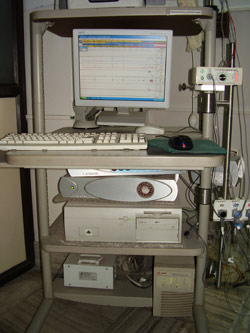Stress Urinary Incontinence
Stress urinary incontinence is a distressing condition in which women leak urine on coughing, straining or even on minimal activity such as getting up from bed. The condition is common and can be diagnosed by a clinical evaluation. In most patients, a urodynamics test (test for bladder function) is recommended prior to any surgical intervention. In women who opt for surgical correction, placement of a synthetic tape is the procedure of choice. Such tapes can be placed by a minimally invasive approach either through the lower part of the abdomen (Retropubic tapes- TVT) or from below (trans Obturator approach). In some women, one may opt for an autologous rectus fascia sling fashioned out of the woman’s own tissues. This may be preferable in women with very poor urethral function or those with prior failed procedures with an unhealthy vagina.

Advanced-Laborie-Urodynamics-Machine
- Pelvic exam- Done in Gynecological office provides important clues for the underlying cause of such pain. Infection, abnormal growths or tense pelvic floor muscles can be diagnosed by the same.
- Urine tests- to rule out urinary tract infections.
- Ultrasound- Detects masses or cysts in the ovaries, uterus or fallopian tubes. Endometriosis and fibroids can also be diagnosed by USG. Can check for residual urine.
- Urodynamics- It is a detailed test for the function of the bladder. It tells about the leak of urine, bladder contractility and can differentiate form urge incontinence which is a different type of urinary incontinence.
Overactive bladder
Overactive bladder is a distressing problem that can affect both men and women. Women with overactive bladder are more likely to have difficulty controlling the leak (the so-called OAB-wet). Overactive bladder is presumably due to an irritability of the bladder (detrusor overactivity) but there are many individuals in whom such irritability cannot be demonstrated. Excessive fluid intake can aggravate the symptoms. Diagnosis rests on a careful clinical assessment to rule out other causes of the symptoms, preparation of 24hr diary records, ultrasonography and rarely urodynamics. Treatment consists of lifestyle changes, fluid restriction, use of anticholinergic medication and pelvic floor training. In some patients one may have to resort to more aggressive treatments such as botulinum toxin injections into the bladder wall or rarely even surgery.
Painful Bladder syndrome
Painful bladder syndrome (also called Interstitial cystitis) is a notoriously difficult condition to treat. The symptom complex is one of pain associated with the bladder, pelvic pain, urinary frequency and vaginal pain or vaginismus in women. There is no specific diagnostic test. Diagnosis hinges on detailed clinical evaluation and exclusion of other causes of pain. Patients will often be asked to fill questionnaires regarding their problem or may be asked to prepare diary records. Some patients may undergo urodynamics, imaging and cystoscopy with bladder distension and evaluation of bladder wall changes. A biopsy may also be taken from the bladder. Treatment is complex and no single treatment works for all patients. A step-wise approach consists of oral medication, hydro-distension of the bladder under anaesthesia and periodic instillation of medication into the bladder. For patients who fail to respond to these therapies, botulinum toxin injections into the bladder or surgical treatment may rarely be required.

Glomerulations (bleeding spots) in PBS-IC

cystoscopy-hunner-ulcers

View during surgery for Painful bladder

